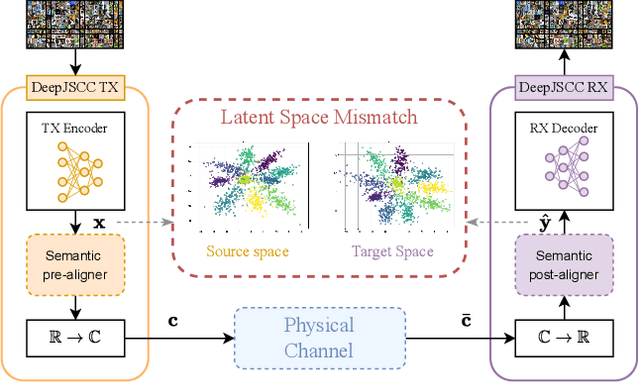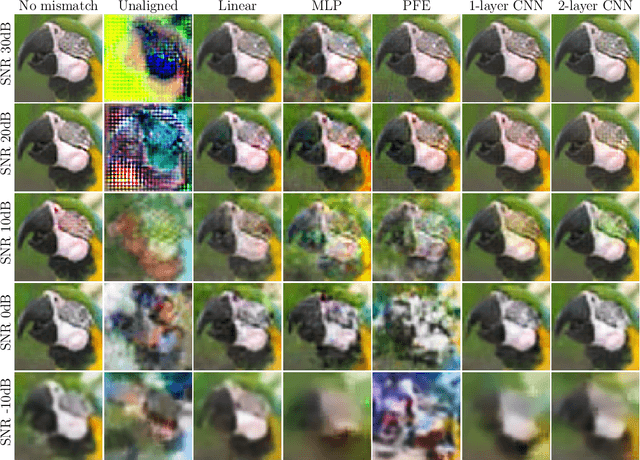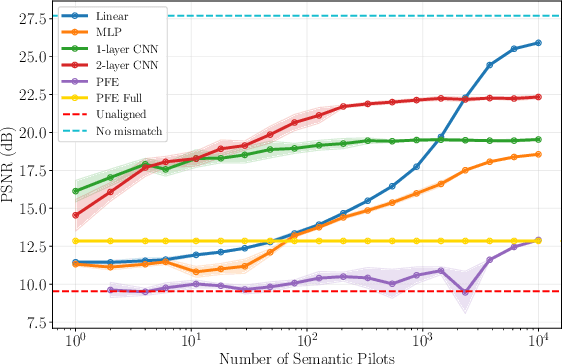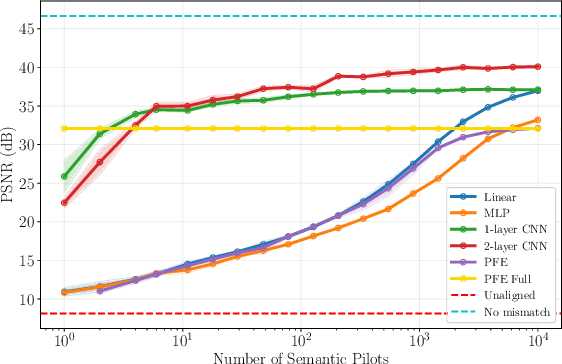Simone Fiorellino
Semantic Channel Equalization Strategies for Deep Joint Source-Channel Coding
Oct 06, 2025



Abstract:Deep joint source-channel coding (DeepJSCC) has emerged as a powerful paradigm for end-to-end semantic communications, jointly learning to compress and protect task-relevant features over noisy channels. However, existing DeepJSCC schemes assume a shared latent space at transmitter (TX) and receiver (RX) - an assumption that fails in multi-vendor deployments where encoders and decoders cannot be co-trained. This mismatch introduces "semantic noise", degrading reconstruction quality and downstream task performance. In this paper, we systematize and evaluate methods for semantic channel equalization for DeepJSCC, introducing an additional processing stage that aligns heterogeneous latent spaces under both physical and semantic impairments. We investigate three classes of aligners: (i) linear maps, which admit closed-form solutions; (ii) lightweight neural networks, offering greater expressiveness; and (iii) a Parseval-frame equalizer, which operates in zero-shot mode without the need for training. Through extensive experiments on image reconstruction over AWGN and fading channels, we quantify trade-offs among complexity, data efficiency, and fidelity, providing guidelines for deploying DeepJSCC in heterogeneous AI-native wireless networks.
Latent Space Alignment for AI-Native MIMO Semantic Communications
Jul 24, 2025Abstract:Semantic communications focus on prioritizing the understanding of the meaning behind transmitted data and ensuring the successful completion of tasks that motivate the exchange of information. However, when devices rely on different languages, logic, or internal representations, semantic mismatches may occur, potentially hindering mutual understanding. This paper introduces a novel approach to addressing latent space misalignment in semantic communications, exploiting multiple-input multiple-output (MIMO) communications. Specifically, our method learns a MIMO precoder/decoder pair that jointly performs latent space compression and semantic channel equalization, mitigating both semantic mismatches and physical channel impairments. We explore two solutions: (i) a linear model, optimized by solving a biconvex optimization problem via the alternating direction method of multipliers (ADMM); (ii) a neural network-based model, which learns semantic MIMO precoder/decoder under transmission power budget and complexity constraints. Numerical results demonstrate the effectiveness of the proposed approach in a goal-oriented semantic communication scenario, illustrating the main trade-offs between accuracy, communication burden, and complexity of the solutions.
RIS-aided Latent Space Alignment for Semantic Channel Equalization
Jul 23, 2025Abstract:Semantic communication systems introduce a new paradigm in wireless communications, focusing on transmitting the intended meaning rather than ensuring strict bit-level accuracy. These systems often rely on Deep Neural Networks (DNNs) to learn and encode meaning directly from data, enabling more efficient communication. However, in multi-user settings where interacting agents are trained independently-without shared context or joint optimization-divergent latent representations across AI-native devices can lead to semantic mismatches, impeding mutual understanding even in the absence of traditional transmission errors. In this work, we address semantic mismatch in Multiple-Input Multiple-Output (MIMO) channels by proposing a joint physical and semantic channel equalization framework that leverages the presence of Reconfigurable Intelligent Surfaces (RIS). The semantic equalization is implemented as a sequence of transformations: (i) a pre-equalization stage at the transmitter; (ii) propagation through the RIS-aided channel; and (iii) a post-equalization stage at the receiver. We formulate the problem as a constrained Minimum Mean Squared Error (MMSE) optimization and propose two solutions: (i) a linear semantic equalization chain, and (ii) a non-linear DNN-based semantic equalizer. Both methods are designed to operate under semantic compression in the latent space and adhere to transmit power constraints. Through extensive evaluations, we show that the proposed joint equalization strategies consistently outperform conventional, disjoint approaches to physical and semantic channel equalization across a broad range of scenarios and wireless channel conditions.
Relative Representations of Latent Spaces enable Efficient Semantic Channel Equalization
Nov 29, 2024


Abstract:In multi-user semantic communication, language mismatche poses a significant challenge when independently trained agents interact. We present a novel semantic equalization algorithm that enables communication between agents with different languages without additional retraining. Our algorithm is based on relative representations, a framework that enables different agents employing different neural network models to have unified representation. It proceeds by projecting the latent vectors of different models into a common space defined relative to a set of data samples called \textit{anchors}, whose number equals the dimension of the resulting space. A communication between different agents translates to a communication of semantic symbols sampled from this relative space. This approach, in addition to aligning the semantic representations of different agents, allows compressing the amount of information being exchanged, by appropriately selecting the number of anchors. Eventually, we introduce a novel anchor selection strategy, which advantageously determines prototypical anchors, capturing the most relevant information for the downstream task. Our numerical results show the effectiveness of the proposed approach allowing seamless communication between agents with radically different models, including differences in terms of neural network architecture and datasets used for initial training.
Dynamic Relative Representations for Goal-Oriented Semantic Communications
Mar 25, 2024



Abstract:In future 6G wireless networks, semantic and effectiveness aspects of communications will play a fundamental role, incorporating meaning and relevance into transmissions. However, obstacles arise when devices employ diverse languages, logic, or internal representations, leading to semantic mismatches that might jeopardize understanding. In latent space communication, this challenge manifests as misalignment within high-dimensional representations where deep neural networks encode data. This paper presents a novel framework for goal-oriented semantic communication, leveraging relative representations to mitigate semantic mismatches via latent space alignment. We propose a dynamic optimization strategy that adapts relative representations, communication parameters, and computation resources for energy-efficient, low-latency, goal-oriented semantic communications. Numerical results demonstrate our methodology's effectiveness in mitigating mismatches among devices, while optimizing energy consumption, delay, and effectiveness.
TopoX: A Suite of Python Packages for Machine Learning on Topological Domains
Feb 07, 2024

Abstract:We introduce topox, a Python software suite that provides reliable and user-friendly building blocks for computing and machine learning on topological domains that extend graphs: hypergraphs, simplicial, cellular, path and combinatorial complexes. topox consists of three packages: toponetx facilitates constructing and computing on these domains, including working with nodes, edges and higher-order cells; topoembedx provides methods to embed topological domains into vector spaces, akin to popular graph-based embedding algorithms such as node2vec; topomodelx is built on top of PyTorch and offers a comprehensive toolbox of higher-order message passing functions for neural networks on topological domains. The extensively documented and unit-tested source code of topox is available under MIT license at https://github.com/pyt-team.
ICML 2023 Topological Deep Learning Challenge : Design and Results
Oct 02, 2023

Abstract:This paper presents the computational challenge on topological deep learning that was hosted within the ICML 2023 Workshop on Topology and Geometry in Machine Learning. The competition asked participants to provide open-source implementations of topological neural networks from the literature by contributing to the python packages TopoNetX (data processing) and TopoModelX (deep learning). The challenge attracted twenty-eight qualifying submissions in its two-month duration. This paper describes the design of the challenge and summarizes its main findings.
 Add to Chrome
Add to Chrome Add to Firefox
Add to Firefox Add to Edge
Add to Edge